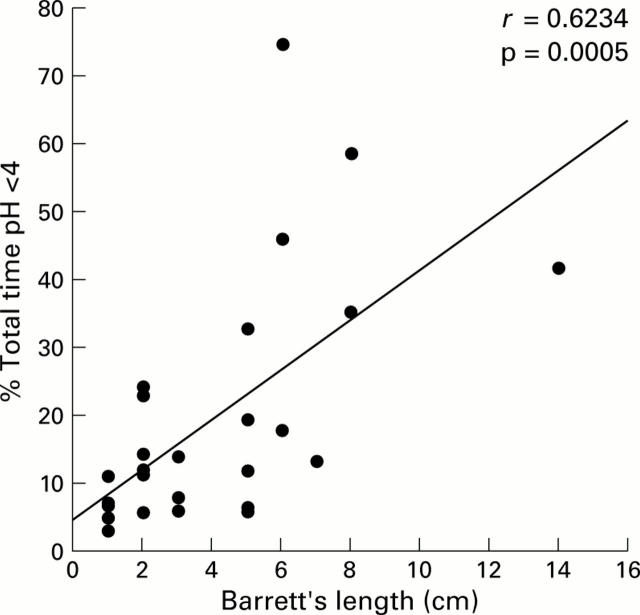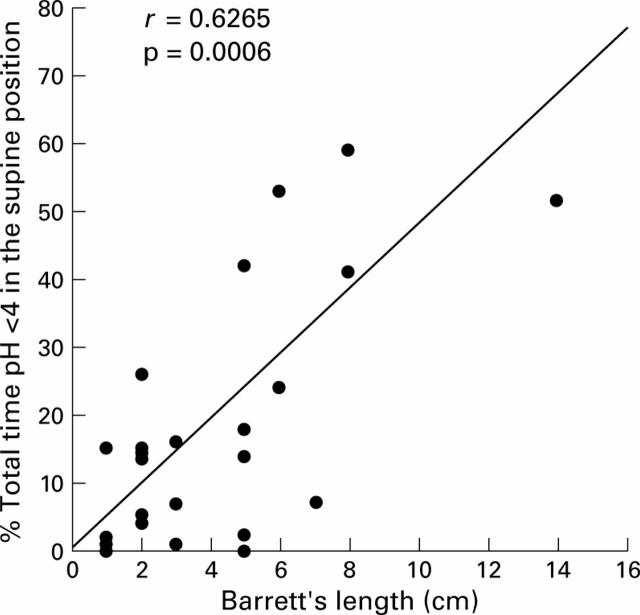Abstract
BACKGROUND—Gastro-oesophageal reflux disease (GORD) plays a major role in the development of Barrett's oesophagus. However, it has yet to be elucidated what factors determine the length of Barrett's mucosa in each individual patient. AIMS—To determine if there is a correlation between oesophageal acid exposure and the length of Barrett's mucosa. We also compared the extent of oesophageal acid exposure between patients with short segment (SSBE) and long segment (LSBE) Barrett's oesophagus. METHODS—Twenty seven patients with Barrett's oesophagus were recruited prospectively into the study from the outpatient gastroenterology clinic at the Southern Arizona VA Health Care System. Diagnosis of Barrett's oesophagus and its anatomical characteristics were determined during upper endoscopy. Ambulatory 24 hour oesophageal pH monitoring assessed the extent of oesophageal acid exposure. RESULTS—There was a significant correlation between per cent total time pH less than 4 and length of Barrett's mucosa (r=0.6234, p=0.0005). In addition, there was a significant correlation between per cent upright and supine time pH less than 4 and length of Barrett's mucosa (r=0.5847, p=0.0014 and r=0.6265 p=0.0006, respectively). Patients with SSBE had significantly less oesophageal acid exposure than patients with LSBE, in terms of both per cent total time and per cent supine time pH less than 4 (p<0.05). CONCLUSIONS—The length of Barrett's mucosa correlated with the duration of oesophageal acid exposure. Patients with LSBE experienced significantly more oesophageal acid exposure than patients with SSBE. Duration of oesophageal acid exposure appears to be an important contributing factor in determining the length of Barrett's mucosa. Keywords: Barrett's oesophagus; intestinal metaplasia; oesophageal pH monitoring; oesophageal acid exposure
Full Text
The Full Text of this article is available as a PDF (123.8 KB).
Figure 1 .
Correlation between length of Barrett's mucosa and per cent total time pH <4.
Figure 2 .
Correlation between length of Barrett's mucosa and per cent supine time pH <4.
Figure 3 .
Correlation between length of Barrett's mucosa and per cent upright time pH <4.
Selected References
These references are in PubMed. This may not be the complete list of references from this article.
- Blot W. J., Devesa S. S., Kneller R. W., Fraumeni J. F., Jr Rising incidence of adenocarcinoma of the esophagus and gastric cardia. JAMA. 1991 Mar 13;265(10):1287–1289. [PubMed] [Google Scholar]
- Cameron A. J., Lomboy C. T. Barrett's esophagus: age, prevalence, and extent of columnar epithelium. Gastroenterology. 1992 Oct;103(4):1241–1245. doi: 10.1016/0016-5085(92)91510-b. [DOI] [PubMed] [Google Scholar]
- Champion G., Richter J. E., Vaezi M. F., Singh S., Alexander R. Duodenogastroesophageal reflux: relationship to pH and importance in Barrett's esophagus. Gastroenterology. 1994 Sep;107(3):747–754. doi: 10.1016/0016-5085(94)90123-6. [DOI] [PubMed] [Google Scholar]
- Chow W. H., Finkle W. D., McLaughlin J. K., Frankl H., Ziel H. K., Fraumeni J. F., Jr The relation of gastroesophageal reflux disease and its treatment to adenocarcinomas of the esophagus and gastric cardia. JAMA. 1995 Aug 9;274(6):474–477. [PubMed] [Google Scholar]
- Clark G. W., DeMeester T. R. Surgical management of Barrett's esophagus. Ann Chir Gynaecol. 1995;84(2):139–144. [PubMed] [Google Scholar]
- Cooper B. T., Neumann C. S., Cox M. A., Iqbal T. H. Continuous treatment with omeprazole 20 mg daily for up to 6 years in Barrett's oesophagus. Aliment Pharmacol Ther. 1998 Sep;12(9):893–897. doi: 10.1046/j.1365-2036.1998.00389.x. [DOI] [PubMed] [Google Scholar]
- Demeester T. R., Johnson L. F., Joseph G. J., Toscano M. S., Hall A. W., Skinner D. B. Patterns of gastroesophageal reflux in health and disease. Ann Surg. 1976 Oct;184(4):459–470. doi: 10.1097/00000658-197610000-00009. [DOI] [PMC free article] [PubMed] [Google Scholar]
- Devesa S. S., Blot W. J., Fraumeni J. F., Jr Changing patterns in the incidence of esophageal and gastric carcinoma in the United States. Cancer. 1998 Nov 15;83(10):2049–2053. [PubMed] [Google Scholar]
- Eisen G. M., Sandler R. S., Murray S., Gottfried M. The relationship between gastroesophageal reflux disease and its complications with Barrett's esophagus. Am J Gastroenterol. 1997 Jan;92(1):27–31. [PubMed] [Google Scholar]
- Fitzgerald R. C., Omary M. B., Triadafilopoulos G. Dynamic effects of acid on Barrett's esophagus. An ex vivo proliferation and differentiation model. J Clin Invest. 1996 Nov 1;98(9):2120–2128. doi: 10.1172/JCI119018. [DOI] [PMC free article] [PubMed] [Google Scholar]
- Hirota W. K., Loughney T. M., Lazas D. J., Maydonovitch C. L., Rholl V., Wong R. K. Specialized intestinal metaplasia, dysplasia, and cancer of the esophagus and esophagogastric junction: prevalence and clinical data. Gastroenterology. 1999 Feb;116(2):277–285. doi: 10.1016/s0016-5085(99)70123-x. [DOI] [PubMed] [Google Scholar]
- Kivilaakso E., Fromm D., Silen W. Effect of bile salts and related compounds on isolated esophageal mucosa. Surgery. 1980 Mar;87(3):280–285. [PubMed] [Google Scholar]
- Klingler P. J., Hinder R. A., Wetscher G. J., Davis D. M., Achem S. R., Seelig M. H., O'Brien P., DeVault K. R. Accurate placement of the esophageal pH electrode for 24-hour pH monitoring using a combined pH/manometry probe. Am J Gastroenterol. 2000 Apr;95(4):906–909. doi: 10.1111/j.1572-0241.2000.01927.x. [DOI] [PubMed] [Google Scholar]
- Laine L., Lewin D., Naritoku W., Estrada R., Cohen H. Prospective comparison of commercially available rapid urease tests for the diagnosis of Helicobacter pylori. Gastrointest Endosc. 1996 Nov;44(5):523–526. doi: 10.1016/s0016-5107(96)70002-0. [DOI] [PubMed] [Google Scholar]
- Loughney T., Maydonovitch C. L., Wong R. K. Esophageal manometry and ambulatory 24-hour pH monitoring in patients with short and long segment Barrett's esophagus. Am J Gastroenterol. 1998 Jun;93(6):916–919. doi: 10.1111/j.1572-0241.1998.00276.x. [DOI] [PubMed] [Google Scholar]
- Oberg S., DeMeester T. R., Peters J. H., Hagen J. A., Nigro J. J., DeMeester S. R., Theisen J., Campos G. M., Crookes P. F. The extent of Barrett's esophagus depends on the status of the lower esophageal sphincter and the degree of esophageal acid exposure. J Thorac Cardiovasc Surg. 1999 Mar;117(3):572–580. doi: 10.1016/s0022-5223(99)70337-5. [DOI] [PubMed] [Google Scholar]
- Ouatu-Lascar R., Fitzgerald R. C., Triadafilopoulos G. Differentiation and proliferation in Barrett's esophagus and the effects of acid suppression. Gastroenterology. 1999 Aug;117(2):327–335. doi: 10.1053/gast.1999.0029900327. [DOI] [PubMed] [Google Scholar]
- Sampliner R. E. Effect of up to 3 years of high-dose lansoprazole on Barrett's esophagus. Am J Gastroenterol. 1994 Oct;89(10):1844–1848. [PubMed] [Google Scholar]
- Sampliner R. E. Practice guidelines on the diagnosis, surveillance, and therapy of Barrett's esophagus. The Practice Parameters Committee of the American College of Gastroenterology. Am J Gastroenterol. 1998 Jul;93(7):1028–1032. doi: 10.1111/j.1572-0241.1998.00362.x. [DOI] [PubMed] [Google Scholar]
- Spechler S. J., Goyal R. K. Barrett's esophagus. N Engl J Med. 1986 Aug 7;315(6):362–371. doi: 10.1056/NEJM198608073150605. [DOI] [PubMed] [Google Scholar]
- Vaezi M. F., Richter J. E. Role of acid and duodenogastroesophageal reflux in gastroesophageal reflux disease. Gastroenterology. 1996 Nov;111(5):1192–1199. doi: 10.1053/gast.1996.v111.pm8898632. [DOI] [PubMed] [Google Scholar]
- Wiener G. J., Morgan T. M., Copper J. B., Wu W. C., Castell D. O., Sinclair J. W., Richter J. E. Ambulatory 24-hour esophageal pH monitoring. Reproducibility and variability of pH parameters. Dig Dis Sci. 1988 Sep;33(9):1127–1133. doi: 10.1007/BF01535789. [DOI] [PubMed] [Google Scholar]
- Winters C., Jr, Spurling T. J., Chobanian S. J., Curtis D. J., Esposito R. L., Hacker J. F., 3rd, Johnson D. A., Cruess D. F., Cotelingam J. D., Gurney M. S. Barrett's esophagus. A prevalent, occult complication of gastroesophageal reflux disease. Gastroenterology. 1987 Jan;92(1):118–124. [PubMed] [Google Scholar]





